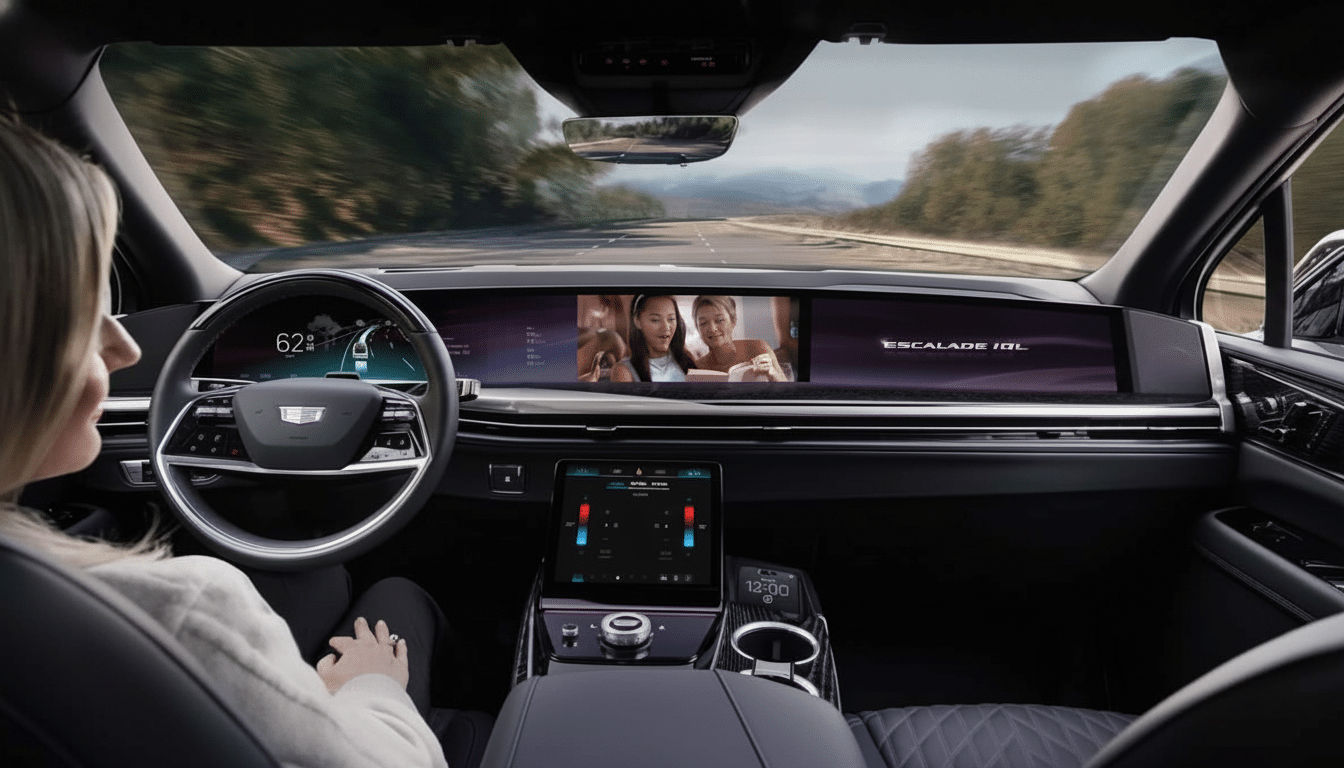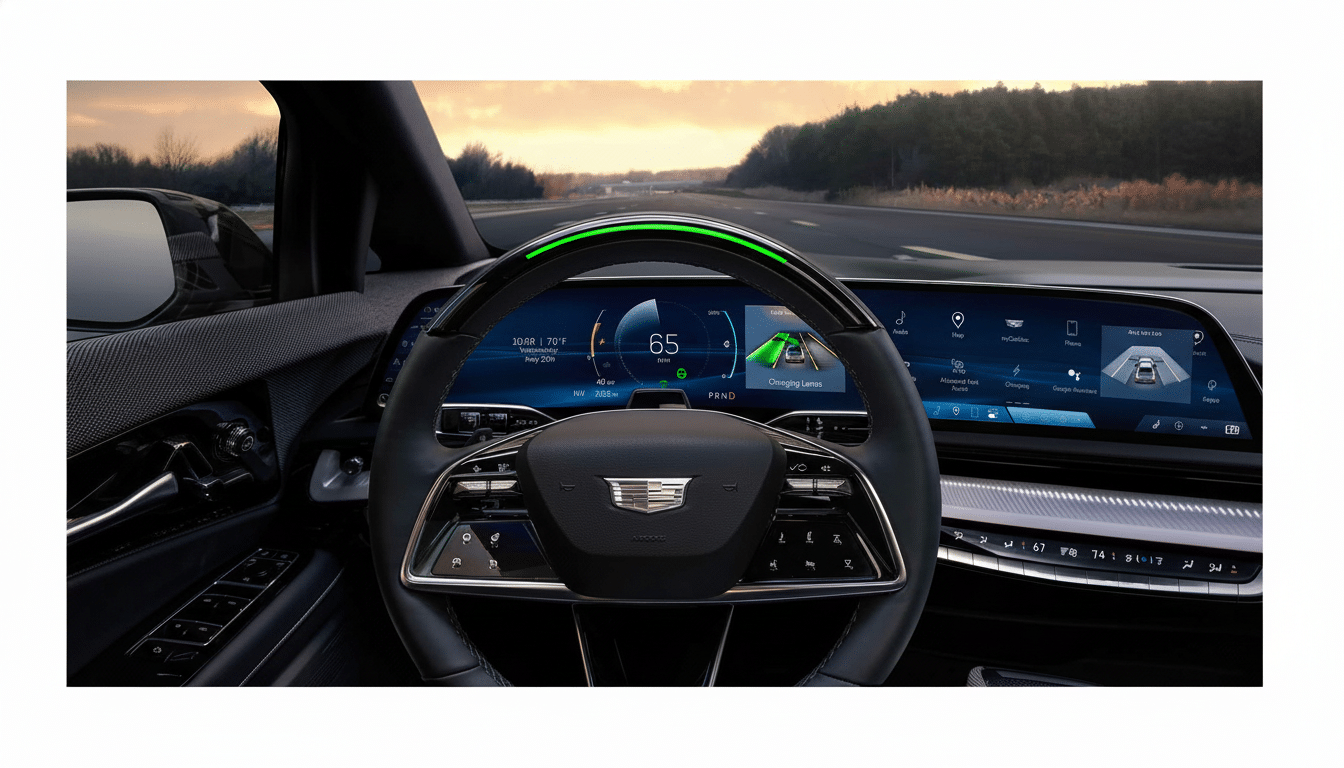Now, though, General Motors is delivering the one upgrade that hardcore Super Cruise users have been asking for: an “eyes-off” mode that actually stops nagging you to keep your eyes pointed ahead. Its next wave of highway automation, Cadillac says, will let drivers look away on approved routes, which is coming first to the Escalade IQ and is signaled by the unique turquoise lighting in the cabin and on its exterior mirrors.
What GM Is Changing in Its New Eyes-Off Super Cruise
Even today’s hands-free systems still demand uninterrupted gaze tracking. Glance away to read a message for a moment or two, and the dashboard chastises you. GM’s new approach is a skosh ‘I, Robot,’ but it avoids constant eye contact, and while the car has control on mapped highways with its hands off the wheel, GM employs in-your-face turquoise cues to tell you when the system is currently driving. The outside lights can also serve as a courtesy signal to other road users, a feature that has already been adopted by Mercedes on models with Drive Pilot.

Importantly, “eyes-off” is not a robotaxi—capable of going anywhere empty. We can call it conditional automation within strict geofences: confined to pre-approved sections of road, which are garden-fenced with a defined set of operating parameters and signs that give you back the wheel with plenty of notice. That transition — from supervised convenience to sustained automation under controlled situations — is the quality-of-life leap road-trippers and long-haul commuters have been waiting for.
How GM’s Tech Stack Enables New Eyes-Off Automation
GM is doubling down on redundancy: LiDAR, radar and cameras fused with high-definition maps, not relying solely on cameras. The company is forthright about its wager here that the whole will be greater than the sum of its parts — multiple sensing modalities offer better perception under rain, glare or low-contrast conditions, and cross-checks when any individual sensor has doubts. That position puts GM in the camp of Mercedes and BMW, and forms a direct opposite to vision-only approaches being promoted elsewhere.
What underlines the capability is a centralized vehicle computing platform that integrates dozens of control units into a single brain. GM says that the architecture allows for millisecond-level response time, real-time security updates and much-improved OTA delivery — aiming to act an order of magnitude faster for new features versus previous generations, plus a rise in in-vehicle data bandwidth to process sensor fusion and future AI workloads. It is part of the same industry shift that others are undertaking to zonal, software-defined architectures, and it’s table stakes for eyes-off automation at scale.
GM is also planning a built-in conversational assistant using Google’s Gemini, with a longer-term transition to an in-house model trained on vehicle-specific knowledge. The short-term win: you talk to the car like a regular person! You can speak conversationally in order to plot a route, change settings or tell the vehicle to interpret a warning — no clumsy menu-diving while the system has its say. You ask for satellite radio by name.

Safety, Signals, and Rules of the Road for Eyes-Off Use
But eyes-off operation will ultimately live or die by safety cases that regulators can accept. The National Highway Traffic Safety Administration has pushed automakers to demonstrate strong fallback behaviors and human-machine interfaces that discourage misuse. The Insurance Institute for Highway Safety has similarly cautioned that driver-assist systems could undermine attention if they are not designed to have strict guardrails. This turquoise-lighting approach matches advice offered by standards organizations like SAE International, with its clear external signals to first responders and other drivers about the automated nature of a vehicle.
Expect conservative constraints. When it appears will depend on weather conditions, the quality of lane markings and how complex traffic is, but the system will also require a takeover if conditions deteriorate. The deal is that, within its realm anyway, the car will handle speed control and lane keeping as well as merges and traffic flow without nagging you to look forward.
What It Means for Drivers and Everyday Road Trips
Super Cruise already includes hundreds of thousands of mapped miles in the United States and Canada. That reach is meaningful: the larger the network of validated highways, the more time you end up actually in eyes-off mode. For many, the most egregious thing about current systems is false alerts from driver monitoring: sunglasses, hats and poor lighting can lead to unnecessary warnings. If the sensor fusion and compute are actually ready, removing that pressure while maintaining a strict system boundary is the right trade-off.
There’s also important context. GM has the technology stack of its defunct robotaxi unit, which ceased operations after a high-profile incident. There are lessons from that incident — around validation, remote updates and just the transparency of an incident — that are all probably baked into this rollout. Factor in the arms race over sensor philosophy, with Tesla’s advocacy of camera-only systems, and GM’s redundancy-first stance is not only a technical choice but a strategic differentiator.
The bottom line: If GM delivers robust eyes-off performance on a set of highways and roadways upon which it says the system is designed to operate, it addresses the everyday annoyance of gaze policing and moves consumer automation closer to real conditional autonomy. The real test will be consistency — how it handles edge cases, how clearly it communicates handoffs, and how often that turquoise glow stays on during the drives that matter most.

